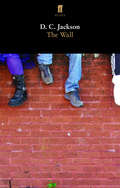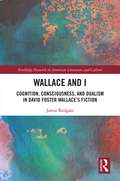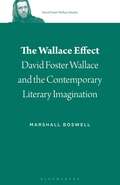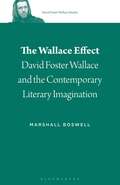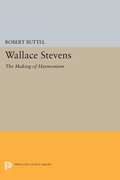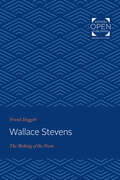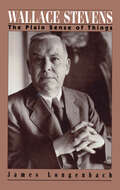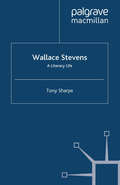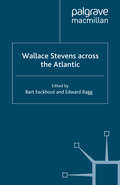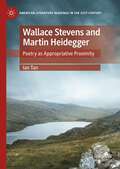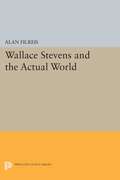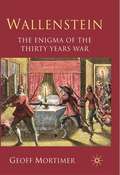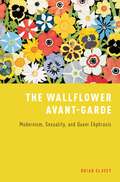- Table View
- List View
The Wall
by D. C. JacksonIn the small Ayrshire town of Stewarton, the school holidays are like a microwave. So much happens and it all happens so fast. Norma Gordon has got a problem. She's going to be in big trouble if her dad finds out. Norma needs to find Rab McGuire fast. Her big brother Barry's no use. He's in love for the first time. Michelle Montgomery loves Barry too but her mum and Aunt Alice just won't let them be together. This summer everything's changing in Stewarton. The Wall premiered at Tron Theatre, Glasgow, in February 2008, in association with Borderline Theatre Company. It is the first part of a trilogy that includes The Ducky and The Chooky Brae.
The Wall and the Arcade: Walter Benjamins Metaphysics of Translation and its Affiliates
by Shimon SandbankTrue translation is transparent: it does not obscure the original, does not stand in its light, but rather allows pure language, as if strengthened by its own medium, to shine even more fully on the original. This is made possible primarily by conveying the syntax word-for-word; and this demonstrates that the word, not the sentence, is translations original element. For the sentence is the wall in front of the language of the original, and word-for-word rendering the arcade. (Walter Benjamin, The Translators Task) The book centers on Walter Benjamins revolutionary essay The Translators Task (1923) which subverts some widespread assumptions concerning translation: that it serves for communication, that it transfers meaning, that it must not distort the translators own language, and that it is inferior to the original. Benjamin overturns these assumptions by replacing the concept of translation as a merely linguistic operation with a metaphysical or theological concept of the same, derived from Jewish Kabbala and French Symbolisme. In The Translators Task, as well as his earlier essay On Language as such and the Language of Man, he delineates a cosmic linguistic cycle of descent from, and ascent back to, God. The translators task is to promote this ascent by deconstructing his own language in order to advance it towards a final Pure Language. Following an analysis of Benjamins approach, some of its affiliates are discussed in texts by Franz Rosenzweig, Paul Celan (as explicated by Peter Szondi) and Jacques Derrida. Rosenzweig, a translator like Benjamin, is shown to be concerned with more concrete aspects of translation, whereas Derridas autobiographical Monolingualism of the Other, though not focussing on translation, is shown to be an innovative contribution to the metaphysics of translation. Finally, an attempt is made to deal with the question of whether and how this abstract approach can be of help for the concrete practice of Poetry translation. The great poet Hoelderlins German translations of Sophocles testify to the clear, though elusive, practical contribution of this approach and to the importance of Benjamins legacy.
The Wall and the Arcade: Walter Benjamins Metaphysics of Translation and its Affiliates
by Shimon SandbankTrue translation is transparent: it does not obscure the original, does not stand in its light, but rather allows pure language, as if strengthened by its own medium, to shine even more fully on the original. This is made possible primarily by conveying the syntax word-for-word; and this demonstrates that the word, not the sentence, is translations original element. For the sentence is the wall in front of the language of the original, and word-for-word rendering the arcade. (Walter Benjamin, The Translators Task) The book centers on Walter Benjamins revolutionary essay The Translators Task (1923) which subverts some widespread assumptions concerning translation: that it serves for communication, that it transfers meaning, that it must not distort the translators own language, and that it is inferior to the original. Benjamin overturns these assumptions by replacing the concept of translation as a merely linguistic operation with a metaphysical or theological concept of the same, derived from Jewish Kabbala and French Symbolisme. In The Translators Task, as well as his earlier essay On Language as such and the Language of Man, he delineates a cosmic linguistic cycle of descent from, and ascent back to, God. The translators task is to promote this ascent by deconstructing his own language in order to advance it towards a final Pure Language. Following an analysis of Benjamins approach, some of its affiliates are discussed in texts by Franz Rosenzweig, Paul Celan (as explicated by Peter Szondi) and Jacques Derrida. Rosenzweig, a translator like Benjamin, is shown to be concerned with more concrete aspects of translation, whereas Derridas autobiographical Monolingualism of the Other, though not focussing on translation, is shown to be an innovative contribution to the metaphysics of translation. Finally, an attempt is made to deal with the question of whether and how this abstract approach can be of help for the concrete practice of Poetry translation. The great poet Hoelderlins German translations of Sophocles testify to the clear, though elusive, practical contribution of this approach and to the importance of Benjamins legacy.
Wallace and I: Cognition, Consciousness, and Dualism in David Foster Wallace’s Fiction (Routledge Research in American Literature and Culture)
by Jamie RedgateThough David Foster Wallace is well known for declaring that "Fiction’s about what it is to be a fucking human being," what he actually meant by the term "human being" has been quite forgotten. It is a truism in Wallace studies that Wallace was a posthumanist writer, and too theoretically sophisticated to write about characters as having some kind of essential interior self or soul. Though the contemporary, posthuman model of the embodied brain is central to Wallace’s work, so is his critique of that model: the soul is as vital a part of Wallace’s fiction as the bodies in which his souls are housed. Drawing on Wallace’s reading in the science and philosophy of mind, this book gives a rigorous account of Wallace’s dualism, and of his humanistic engagement with key postmodern concerns: authorship; the self and interiority; madness and mind doctors; and free will. If Wallace’s fiction is about what it is to be a human being, this book is about the human ‘I’ at the heart of Wallace’s work.
Wallace and I: Cognition, Consciousness, and Dualism in David Foster Wallace’s Fiction (Routledge Research in American Literature and Culture)
by Jamie RedgateThough David Foster Wallace is well known for declaring that "Fiction’s about what it is to be a fucking human being," what he actually meant by the term "human being" has been quite forgotten. It is a truism in Wallace studies that Wallace was a posthumanist writer, and too theoretically sophisticated to write about characters as having some kind of essential interior self or soul. Though the contemporary, posthuman model of the embodied brain is central to Wallace’s work, so is his critique of that model: the soul is as vital a part of Wallace’s fiction as the bodies in which his souls are housed. Drawing on Wallace’s reading in the science and philosophy of mind, this book gives a rigorous account of Wallace’s dualism, and of his humanistic engagement with key postmodern concerns: authorship; the self and interiority; madness and mind doctors; and free will. If Wallace’s fiction is about what it is to be a human being, this book is about the human ‘I’ at the heart of Wallace’s work.
The Wallace Effect: David Foster Wallace and the Contemporary Literary Imagination (David Foster Wallace Studies)
by Marshall BoswellThe Wallace Effect explores David Foster Wallace's contested space at the forefront of 21st-century American fiction. Pioneering Wallace scholar Marshall Boswell does this by illuminating “The Wallace Effect”-the aura of literary competition that Wallace routinely summoned in his fiction and non-fiction and that continues to inform the reception of his work by his contemporaries. A frankly combative writer, Wallace openly challenged his artistic predecessors as he sought to establish himself as the leading literary figure of the post-postmodern turn. Boswell challenges this portrait in two ways. First, he examines novels by Wallace's literary patriarchs and contemporaries that introduce innovations on traditional metafiction that Wallace would later claim as his own. Second, he explores four novels published after Wallace's ascendency that attempt to demythologize Wallace's persona and his literary preeminence. By re-situating Wallace's work in a broader and more contentious literary arena, The Wallace Effect traces both the reach and the limits of Wallace's legacy.
The Wallace Effect: David Foster Wallace and the Contemporary Literary Imagination (David Foster Wallace Studies #2)
by Marshall BoswellThe Wallace Effect explores David Foster Wallace's contested space at the forefront of 21st-century American fiction. Pioneering Wallace scholar Marshall Boswell does this by illuminating “The Wallace Effect”-the aura of literary competition that Wallace routinely summoned in his fiction and non-fiction and that continues to inform the reception of his work by his contemporaries. A frankly combative writer, Wallace openly challenged his artistic predecessors as he sought to establish himself as the leading literary figure of the post-postmodern turn. Boswell challenges this portrait in two ways. First, he examines novels by Wallace's literary patriarchs and contemporaries that introduce innovations on traditional metafiction that Wallace would later claim as his own. Second, he explores four novels published after Wallace's ascendency that attempt to demythologize Wallace's persona and his literary preeminence. By re-situating Wallace's work in a broader and more contentious literary arena, The Wallace Effect traces both the reach and the limits of Wallace's legacy.
Wallace Stevens: The Making of Harmonium
by Robert ButtelThe years between 1900 and 1915 were a crucial period in Wallace Stevens' poetic career. But until Robert Buttel was given access to 30 manuscript poems written during this time, these years constituted the largest gap in our knowledge of Stevens’ artistic development. These poems, as well as those printed in the Harvard Advocate, are presented in a sequence which allows the reader to view the changes in Stevens’ art during this period.Originally published in 1967.The Princeton Legacy Library uses the latest print-on-demand technology to again make available previously out-of-print books from the distinguished backlist of Princeton University Press. These editions preserve the original texts of these important books while presenting them in durable paperback and hardcover editions. The goal of the Princeton Legacy Library is to vastly increase access to the rich scholarly heritage found in the thousands of books published by Princeton University Press since its founding in 1905.
Wallace Stevens: The Making of the Poem (Princeton Legacy Library #1000)
by Frank DoggettOriginally published in 1980. This book emphasizes the ideas that Wallace Stevens embeds in his poetry, providing the first study to provide an intellectual biography of Stevens. It examines Stevens' naturalism, his ideas of the self, and the imagination, among other topics. The concepts that emerge from long reading of the poetry of Stevens are slight and basic, but these concepts do accord, even if they never emerge into a coherent philosophy. The accordance is probably a result of Stevens' preference for naturalistic thought.
Wallace Stevens: The Plain Sense of Things
by James LongenbachWallace Stevens the poet and Wallace Stevens the insurance executive: for more than one critical generation it has seemed as if these two men were unacquainted--that Stevens was a poet who existed only in the rarefied world of language. However, the idea that Stevens lived a double life, the author maintains, is misleading. This compelling book uncovers what Stevens liked to think of as his "ordinary" life, a life in which the demands of politics, economics, poetry, and everyday distractions coexisted, sometimes peacefully and sometimes not. Examining the full scope of Stevens's career (from the student-poet of the nineteenth century to the award-winning poet of the Cold War years), Longenbach reveals that Stevens was not only aware of events taking place around him, but often inspired by those events. The major achievements of Stevens's career are shown to coalesce around the major historical events of his lifetime (the Great Depression and two World Wars); but Longenbach also dwells on Stevens's two extended periods of poetic silence, exploring the crucial aspects of Steven's life that were not exclusively poetic. Longenbach demonstrates that through Stevens's work in surety law he was far more intimately acquainted with legal and economic concerns than most poets, and he consequently thought deeply about the strengths--and, equally important, the limitations--of poetry as a social product and force.
Wallace Stevens: A Literary Life (Literary Lives)
by T. SharpeTony Sharpe explores the symbiotic and antagonistic relations between Stevens's literary life and his working life as insurance executive, outlining the personal, historical and publishing contexts that shaped his writing career, and suggesting how awareness of these contexts throws new light on the poems. In this appreciative but not uncritical study, Sharpe tries to see the man behind the mandarin, whilst remaining alert to the challengingly sumptuous austerities of one of America's most significant poets.
Wallace Stevens across the Atlantic
by B. Eeckhout E. RaggIn a unique collection of essays devoted to one of America's most significant twentieth-century poets, a group of international contributors considers the Transatlantic nature of Stevens' poetry, providing original accounts of how a poet wary of 'influence' created a poetics which continues to haunt contermporary verse.
Wallace Stevens and Martin Heidegger: Poetry as Appropriative Proximity (American Literature Readings in the 21st Century)
by Ian TanThis book is a unique contribution to scholarship of the poetics of Wallace Stevens, offering an analysis of the entire oeuvre of Stevens’s poetry using the philosophical framework of Martin Heidegger. Marking the first book-length engagement with a philosophical reading of Stevens, it uses Heidegger’s theories as a framework through which Stevens’s poetry can be read and shows how philosophy and literature can enter into a productive dialogue. It also makes a case for a Heideggerian reading of poetry, exploring his later philosophy with respect to his writing on art, language, and poetry. Taking Stevens’s repeated emphasis on the terms “being”, “consciousness”, “reality” and “truth” as its starting point, the book provides a new reading of Stevens with a philosopher who aligns poetic insight with a reconceptualization of the metaphysical significance of these concepts. It pursues the link between philosophy, American poetry as reflected through Stevens, and modernist poetics, looking from Stevens’s modernist techniques to broader European philosophical movements of the twentieth century.
Wallace Stevens and the Actual World
by Alan FilreisThe work of Wallace Stevens has been read most widely as poetry concerned with poetry, and not with the world in which it was created; deemed utterly singular, it seems to resist being read as the record of a life and times. In this critical biography Alan Filreis presents a detailed challenge to this exceptionalist view as he traces two major periods of Stevens's career from 1939 to 1955, the war years and the postwar years. Portraying Stevens as someone whose alternation between cultural comprehension and ignorance was itself characteristically American, Filreis examines the poet's impulse to disguise and compress the very fact of his debt to the actual world. By actual world Stevens meant historical conditions, often in order to impugn his own interest in such externalities as the last resort of a man whose famous interiority made him feel desperately irrelevant. In light of events ranging from the U.S. entry into World War II to the Cold War, Filreis shows how Stevens was driven to make a "close approach to reality" in an effort to reconcile his poetic language with a cultural language. "Wallace Stevens and the Actual World is not only an impressive feat of historical recovery and analysis, but also a pleasure to read. It will be useful to anyone interested in the relationship between American politics and literature during World War II and the Cold War."--Milton J. Bates, Marquette UniversityOriginally published in 1991.The Princeton Legacy Library uses the latest print-on-demand technology to again make available previously out-of-print books from the distinguished backlist of Princeton University Press. These editions preserve the original texts of these important books while presenting them in durable paperback and hardcover editions. The goal of the Princeton Legacy Library is to vastly increase access to the rich scholarly heritage found in the thousands of books published by Princeton University Press since its founding in 1905.
Wallace Stevens and the Contemporary Irish Novel: Order, Form, and Creative Un-Doing (Routledge Studies in Irish Literature)
by Ian TanWallace Stevens and the Contemporary Irish Novel is a major contribution to the study of the literary influence of the American modernist poet Wallace Stevens. Stevens’s lifelong poetic quest for order and the championing of the creative affordances of the imagination finds compelling articulation in the positioning of the Irish novel as a response to larger legacies of Anglo-American modernism, and how aesthetic re-imagining can be possible in the aftermath of the destruction of certainties and literary tradition heralded by postmodern practice and metatextual consciousness. It is this book’s argument that intertextual influences flowing from Stevens’s poetry towards the vitality of the novelistic imagination enact robust dialectical exchanges between existential chaos and artistic order, contemporary form and poetic precursors. Through readings of novels by important contemporary Irish novelists John Banville, Colum McCann, Ed O’Loughlin, Iris Murdoch, and Emma Donoghue, this book contemporizes Stevens’s literary influence with refence to novelistic style, themes, and thematic preoccupations that stake the claim for the international status of the contemporary Irish novel as it shapes a new understanding of “world literature” as exchange between national languages, cultures, and alternative formulations of aesthetic modernity as continuing project.
Wallace Stevens and the Contemporary Irish Novel: Order, Form, and Creative Un-Doing (Routledge Studies in Irish Literature)
by Ian TanWallace Stevens and the Contemporary Irish Novel is a major contribution to the study of the literary influence of the American modernist poet Wallace Stevens. Stevens’s lifelong poetic quest for order and the championing of the creative affordances of the imagination finds compelling articulation in the positioning of the Irish novel as a response to larger legacies of Anglo-American modernism, and how aesthetic re-imagining can be possible in the aftermath of the destruction of certainties and literary tradition heralded by postmodern practice and metatextual consciousness. It is this book’s argument that intertextual influences flowing from Stevens’s poetry towards the vitality of the novelistic imagination enact robust dialectical exchanges between existential chaos and artistic order, contemporary form and poetic precursors. Through readings of novels by important contemporary Irish novelists John Banville, Colum McCann, Ed O’Loughlin, Iris Murdoch, and Emma Donoghue, this book contemporizes Stevens’s literary influence with refence to novelistic style, themes, and thematic preoccupations that stake the claim for the international status of the contemporary Irish novel as it shapes a new understanding of “world literature” as exchange between national languages, cultures, and alternative formulations of aesthetic modernity as continuing project.
Wallace Stevens In Theory (Liverpool English Texts and Studies #101)
by Thomas Gould and Ian TanThe modernist poetry of Wallace Stevens is replete with moments of theorizing. Stevens regarded poetry as an abstract medium through which to think about and theorize not only philosophical concepts like metaphor and reality, but also a unifying thesis about the nature of poetry itself. At the same time, literary theorists and philosophers have often turned to Stevens as a canonical reference point and influence. In the centenary year of Wallace Stevens’s first collection Harmonium (1923), this collection asks what it means to theorize with Stevens today. Through a range of critical and theoretical perspectives, this book seeks to describe the myriad kinds of thinking sponsored by Stevens’s poetry and explores how contemporary literary theory might be invigorated through readings of Stevens.
Wallace Stevens In Theory (Liverpool English Texts and Studies #101)
The modernist poetry of Wallace Stevens is replete with moments of theorizing. Stevens regarded poetry as an abstract medium through which to think about and theorize not only philosophical concepts like metaphor and reality, but also a unifying thesis about the nature of poetry itself. At the same time, literary theorists and philosophers have often turned to Stevens as a canonical reference point and influence. In the centenary year of Wallace Stevens’s first collection Harmonium (1923), this collection asks what it means to theorize with Stevens today. Through a range of critical and theoretical perspectives, this book seeks to describe the myriad kinds of thinking sponsored by Stevens’s poetry and explores how contemporary literary theory might be invigorated through readings of Stevens.
Wallace’s Dialects (David Foster Wallace Studies)
by Mary ShapiroMary Shapiro explores the use of regional and ethnic dialects in the works of David Foster Wallace, not just as a device used to add realism to dialogue, but as a vehicle for important social commentary about the role language plays in our daily lives, how we express personal identity, and how we navigate social relationships. Wallace's Dialects straddles the fields of linguistic criticism and folk linguistics, considering which linguistic variables of Jewish-American English, African-American English, Midwestern, Southern, and Boston regional dialects were salient enough for Wallace to represent, and how he showed the intersectionality of these with gender and social class. Wallace's own use of language is examined with respect to how it encodes his identity as a white, male, economically privileged Midwesterner, while also foregrounding characteristic and distinctive idiolect features that allowed him to connect to readers across implied social boundaries.
Wallace’s Dialects (David Foster Wallace Studies #3)
by Mary ShapiroMary Shapiro explores the use of regional and ethnic dialects in the works of David Foster Wallace, not just as a device used to add realism to dialogue, but as a vehicle for important social commentary about the role language plays in our daily lives, how we express personal identity, and how we navigate social relationships. Wallace's Dialects straddles the fields of linguistic criticism and folk linguistics, considering which linguistic variables of Jewish-American English, African-American English, Midwestern, Southern, and Boston regional dialects were salient enough for Wallace to represent, and how he showed the intersectionality of these with gender and social class. Wallace's own use of language is examined with respect to how it encodes his identity as a white, male, economically privileged Midwesterner, while also foregrounding characteristic and distinctive idiolect features that allowed him to connect to readers across implied social boundaries.
Wallenstein: The Enigma of the Thirty Years War
by G. MortimerAlbrecht Wallenstein was a legendary military commander and generalissimo of the Habsburg forces, yet was eventually assassinated on the orders of Emperor Ferdinand II. This accessible modern biography of Wallenstein for the English-speaking reader dispels the many historical myths surrounding this central character of the Thirty Years War.
Wallenstein: A Dramatic Poem (Open Book Classics #5)
by Friedrich SchillerBy the time Frederich Schiller came to write the Wallenstein trilogy, his reputation as one of Germany’s leading playwrights was all but secured. Consisting of Wallenstein’s Camp, The Piccolomini and The Death of Wallenstein, this suite of plays appeared between 1798 and 1799, each production under the original direction of Schiller’s collaborator and mentor, Johann Wolfgang (von) Goethe. Across the three plays, which are now commonly performed and printed together, Schiller charts the thwarted rebellion of General Albrecht von Wallenstein. Based loosely on the events of the Thirty Years' War, the trilogy provides a unique vantage on an army’s loyalty to their commander and the machinations and intrigues of international diplomacy, giving insight into the military hero who is placed on the threshold between these forces as they are increasingly pitted against one another. The Wallenstein trilogy, formally innovative and modern beyond its time, is a brilliant study of power, ambition and betrayal. In this new translation—the latest in a long line of distinguished English translations of the play, starting with Coleridge's in Schiller's lifetime—Flora Kimmich succeeds in rendering what is often a difficult source text into language that is at once accessible and enjoyable. Coupled with a complete and careful commentary and a glossary, both of which are targeted to undergraduates, and accompanied by an authoritative introductory essay by Roger Paulin, this edition also includes embedded readings in German of the play and links to the original German text. It will be an invaluable resource for students of German, European literature and history, and military history, as well as to all readers approaching this important set of plays for the first time.
Wallenstein: A Dramatic Poem (1827) (Open Book Classics Ser. #Vol. 5)
by Friedrich Schiller Flora KimmichBy the time Frederich Schiller came to write the Wallenstein trilogy, his reputation as one of Germany’s leading playwrights was all but secured. Consisting of Wallenstein’s Camp, The Piccolomini and Wallenstein’s Death, this suite of plays appeared between 1798 and 1799, each production under the original direction of Schiller’s collaborator and mentor, Johann Wolfgang von Goethe. Across the three plays, which are now commonly performed and printed together, Schiller charts the thwarted rebellion of General Albrecht von Wallenstein. Based loosely on the events of the Thirty Years’ War, the trilogy provides a unique perspective on an army’s loyalty to their commander and the machinations and intrigues of international diplomacy, giving insight into the military hero who is placed on the threshold between these forces as they are increasingly pitted against one another. The Wallenstein trilogy, formally innovative and modern beyond its time, is a brilliant study of power, ambition and betrayal. In this new translation—the latest in a long line of distinguished English translations starting with Coleridge’s in Schiller’s lifetime—Flora Kimmich succeeds in rendering what is often a difficult source text into language that is at once accessible and enjoyable. Coupled with a complete and careful commentary and a glossary, both of which are targeted to undergraduates, it is accompanied by an authoritative introductory essay by Roger Paulin. Kimmich’s translation will be an invaluable resource for students of German, European literature and history, and military history, as well as to all readers approaching this important set of plays for the first time.
The Wallflower Avant-Garde: Modernism, Sexuality, and Queer Ekphrasis
by Brian GlaveyThe Wallflower Avant-Garde highlights a strain of formalism visible in both modernist literature and contemporary queer studies, drawing attention to an aesthetic that is as quiet and quirky as it is queer. In studies of Gertrude Stein, Djuna Barnes, Richard Bruce Nugent, Frank O'Hara, and John Ashbery, Brian Glavey argues for a recalibrated understanding of the relation between sexuality and the aesthetic, revealing a non-oppositional avant-gardism that opts out of some of the binaristic imperatives that have structured recent debates in queer theory. Refusing to decide between positive and negative affects or to side with either utopian or antisocial ambitions, The Wallflower Avant-Garde explores models of reading and writing about art that remain flexible enough to dig deep even as they gloss the surface. At the heart of this argument is a revaluation of modernist ekphrasis, a mode understood as literature's imitation or description of the visual arts. From the well-wrought urns of the New Critics onward, ekphrasis has figured prominently in the legacy of modernist literary criticism, but a tendency to read its complicated modes of relationality in terms of either autonomy or antagonism has obscured the forms of creative failure and imitation embodied in the desire to confuse poetry for pottery. Attending to mimetic and descriptive strategies without dismissing the aspirations for wholeness and closure that often animate them allows for the recognition that queerness and modernism are intertwined in unexpected and unpredictable ways, revealing new insights into the varieties of abstraction, preterition, and spatial form that stand behind modernism's investment in the aesthetic.
The Wallflower Avant-Garde: Modernism, Sexuality, and Queer Ekphrasis
by Brian GlaveyThe Wallflower Avant-Garde highlights a strain of formalism visible in both modernist literature and contemporary queer studies, drawing attention to an aesthetic that is as quiet and quirky as it is queer. In studies of Gertrude Stein, Djuna Barnes, Richard Bruce Nugent, Frank O'Hara, and John Ashbery, Brian Glavey argues for a recalibrated understanding of the relation between sexuality and the aesthetic, revealing a non-oppositional avant-gardism that opts out of some of the binaristic imperatives that have structured recent debates in queer theory. Refusing to decide between positive and negative affects or to side with either utopian or antisocial ambitions, The Wallflower Avant-Garde explores models of reading and writing about art that remain flexible enough to dig deep even as they gloss the surface. At the heart of this argument is a revaluation of modernist ekphrasis, a mode understood as literature's imitation or description of the visual arts. From the well-wrought urns of the New Critics onward, ekphrasis has figured prominently in the legacy of modernist literary criticism, but a tendency to read its complicated modes of relationality in terms of either autonomy or antagonism has obscured the forms of creative failure and imitation embodied in the desire to confuse poetry for pottery. Attending to mimetic and descriptive strategies without dismissing the aspirations for wholeness and closure that often animate them allows for the recognition that queerness and modernism are intertwined in unexpected and unpredictable ways, revealing new insights into the varieties of abstraction, preterition, and spatial form that stand behind modernism's investment in the aesthetic.
